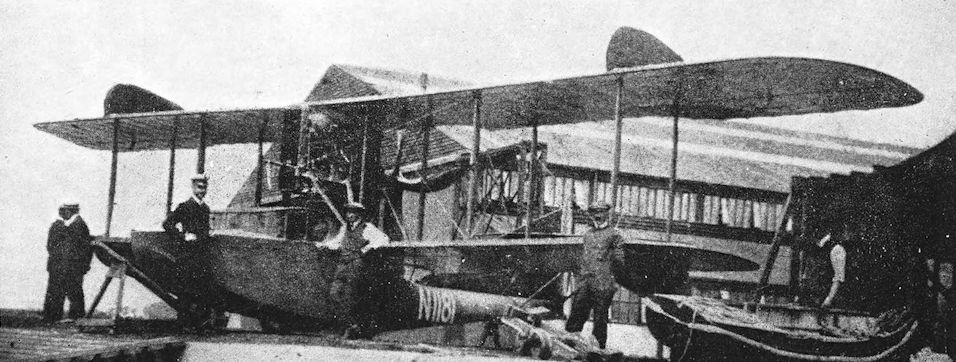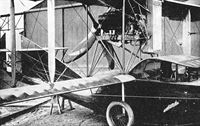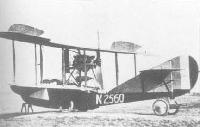G.Duval British Flying-Boats and Amphibians 1909-1952 (Putnam)
Norman Thompson N.T.2B (1916)
A development of the White and Thompson No. 3 Boat of 1914, the N.T.2B was powered initially by the 160 h.p. Beardmore pusher engine. The crew of two were enclosed in a cabin fitted with side-by-side seating and dual control, and in common with other machines produced by this company, the after part of the hull was extremely narrow with a long dorsal tail fin, while the wing-tip floats were attached directly to the undersurface of the lower wing. Accepted by the Admiralty, the N.T.2B was ordered into production, some of the first batch of fifty machines being fitted with the 150 h.p. Hispano- Suiza engine, examples of this being N2555 and N2561. The machine proved to be a great success, and the production requirements soon outstripped the capability of the Norman Thompson works alone, so construction contracts were opened with S. E. Saunders at Cowes, and with Supermarine at Woolston, Southampton. Late in 1917, it was decided to fit the 200 h.p. Sunbeam Arab engine, which, owing to its greater torque, had to be mounted slightly starboard of centre. An example of the Arab-powered N.T.2B was machine N2294. This engine, however, fell short of requirements, and the ultimate production version was fitted with the 200 h.p. Hispano-Suiza, the torque problem in this case being dealt with by slewing the engine mounting. The first 200 h.p. machine was N2569.
Altogether, more than one hundred and fifty machines were built, remaining the standard training type for flying-boat pilots until the Armistice, supplemented by smaller numbers of other machines. They served with the R.N.A.S. at Calshot, Lee-on-Solent, and Felixstowe.
No further development took place, owing to the fact that Norman Thompson was absorbed by Handley Page, Ltd. The latter company sent two machines to Peru in 1919, for air transport work. These were N2284 and N2293. One N.T.2B was on the civilian register as G-EAQO.
SPECIFICATION
Power Plant:
Prototype/early production - 160 h.p. Beardmore
Some early production - 150 h.p. Hispano-Suiza
Trial installation, 1917 - 200 h.p. Sunbeam Arab
Late production - 200 h.p. Hispano-Suiza
Span: 48 feet 4 3/4 inches
Length: 27 feet 4 1/2 inches
Weight Loaded: Sunbeam Arab - 3,169 pounds
Total Area: 453 square feet
Max. Speed: Sunbeam Arab - 85 m.p.h.
Endurance: Not available
Armament: Nil
J.Bruce British Aeroplanes 1914-1918 (Putnam)
Norman Thompson N.T.2B
THE Norman Thompson Flight Company were contractors for the construction of the little F.B.A. trainer flying-boat, a frail-looking machine of French origin which nevertheless performed much useful work in training flying-boat pilots.
For the same purpose the Bognor company produced a workmanlike and more substantial two-seat flying-boat which was obviously a descendant of the White and Thompson No. 3 Flying-boat. The new Norman Thompson machine was known as the N.T.2B, a designation which conflicted oddly with that of its immediate predecessor, the N.T.4. It seems probable, however, that the two-seater came within the Admiralty category N.2B, whence the numeral might have been derived.
The hull was somewhat similar in general appearance to that of the White and Thompson No. 3, but had improved lines. It was a boat-built structure with a single step: over a framework of formers and stringers were applied two thicknesses of planking with a layer of oiled calico between them; the outer planking ran fore and aft. A neat enclosed cabin was provided for the instructor and his pupil, who sat side-by-side. Dual control was, of course, fitted.
The two-bay wings were of unequal span: the extensions of the upper wings were braced from kingposts which were enclosed in fin surfaces of characteristic shape, situated above the outer pairs of interplane struts. Only the upper wings had ailerons, which projected behind the trailing edge of the mainplane.
Abaft the wings the hull was little more than a boom to support the tail-unit. The vertical surfaces were very similar to those of the N.T.4, and the tailplane was set high on the fin. The bottom of the rudder was covered with plywood, and a beaching skid was fitted under the stern-post.
Power was provided by a 160 h.p. Beardmore engine mounted between the wings and driving a four-bladed pusher airscrew. The engine was completely uncowled, and a tall rectangular radiator was mounted in front of the installation. The starting crank handle protruded through the radiator.
The N.T.2B was accepted by the Admiralty and was ordered into production. It seems probable that most of the first fifty production machines had the Beardmore engine, though some are known to have had the 150 h.p. Hispano-Suiza. Late in 1917 it was decided to fit a more powerful unit.
First choice fell on the 200 h.p. Sunbeam Arab, and it seems that the first installation was made in N.2294, an N.T.2B which had originally had a Beardmore. The more powerful engine brought with it some problems of longitudinal control. Its torque was greater than that of the Beardmore, and had to be overcome by mounting the engine slightly to starboard of centre.
The N.T.2B proved to be a useful little flying-boat, so much so that R.N.A.S. demands for it exceeded the production capacity of the Norman Thompson works. Contracts were therefore given to S. E. Saunders and the Supermarine Aviation Works, and both firms built the N.T.2B under licence.
In view of the Sunbeam Arab’s ill-starred career, it comes as no surprise to learn that the ultimate production version was powered by the 200 h.p. Hispano-Suiza engine. Again the problem of torque reaction arose, and ultimately a form of slewed engine mounting was evolved. This mounting was tested on N.2569 and proved to be satisfactory. The installation of the Hispano-Suiza was similar to that of the Sunbeam Arab, but could be distinguished by the starting crank handle running through the radiator: the Arab had no such frontal handle.
The N.T.2B remained the standard flying-boat trainer until the Armistice. No further development of the design took place because of the absorption of the Norman Thompson company by Handley Page Ltd. The latter firm sent two N.T.2Bs (N.2284 and N.2293) to Peru to pioneer air transportation in 1919, but beyond that the type did not survive for long.
SPECIFICATION
Manufacturers: The Norman Thompson Flight Co., Ltd., Bognor Regis, Sussex.
Other Contractors: S. E. Saunders, Ltd., East Cowes, Isle of Wight; The Supermarine Aviation Works, Ltd., Woolston, Southampton.
Power: 160 h.p. Beardmore; 200 h.p. Sunbeam Arab; 150 h.p. Hispano-Suiza; 200 h.p. Hispano-Suiza.
Dimensions: Span: upper 48 ft 4 3/4 in., lower 27 ft 6 3/4 in. Length: 27 ft 4 1/2 in. Height: 10 ft 8 in. Chord: 5 ft 6 in. Gap: 5 ft 6 in. Stagger: nil. Dihedral: 1°. Incidence: 5°.
Areas: Wings: 453 sq ft.
Weights and Performance (with Sunbeam Arab engine): No. of Trial Report: N.M.211. Date of Trial Report: August 15th, 1918. Type of airscrew used on trial: D.1465. Weight empty: 2,321 lb. Military load: nil. Crew: 360 lb. Fuel and oil: 488 lb. Loaded: 3,169 lb. Maximum speed at 2,000 ft: 85 m.p.h.; at 6,500 ft: 83-5 m.p.h.; at 10,000 ft: 80-5 m.p.h. Climb to 2,000 ft: 4 min 10 sec; to 6,500 ft: 16 min 50 sec; to 10,000 ft: 33 min 40 sec. Service ceiling: 11,400 ft.
Tankage: Petrol: 60 gallons. Oil: 8 gallons.
Service Use: Used for training purposes at R.N.A.S. Stations Calshot, Lee-on-Solent, Felixstowe.
Production and Allocation: Precise figures are not available, but it seems probable that over 150 Norman Thompson N.T.2Bs were built. On October 31st, 1918, the R.A.F. had seventy-nine on charge. Only twenty-three were at coastal stations; two were with contractors; three were at experimental units; the remaining fifty-one were in store.
Serial Numbers: N.1180-N.1189: built by Norman Thompson. N.2260-N.2359: built by Norman Thompson. N.2400 and onwards, probably to N.2419 at least. N.2500-N.2523: built by Saunders. N.2555-N.2579: built by Norman Thompson. N.2760-N.2789: built by Supermarine.� Notes on Individual Machines: N. 1189: R.N.A.S., Lee-on-Solent. N.2268: R.N.A.S., Lee-on-Solent. N.2284 and N.2293 went to Peru in 1919. N.2290: became G-EAQO. N.2555: R.N.A.S., Calshot (this N.T.2B had a 150 h.p. Hispano-Suiza engine). N.2561: R.N.A.S., Calshot. N.2569: first slewed engine installation.
Costs:
Airframe without engine and instruments £1,477 0s.
Engines:
160 h.p. Beardmore £1,045 0s.
Sunbeam Arab £1,017 10s.
200 h.p. Hispano-Suiza £1,004 0s.
O.Thetford British Naval Aircraft since 1912 (Putnam)
NORMAN THOMPSON N.T.2B
Two-seat dual-control training flying-boat used by the RNAS in 1917-18. It entered service at Calshot, Felixstowe and Lee-on-Solent, and 79 were still on charge at the time of the Armistice. It was built under licence by S E Saunders Ltd of Cowes and the Supermarine Aviation Works as well as by the parent company. The example illustrated (N2569) is one of the later production versions built by Norman Thompson and is fitted with a 200 hp Hispano-Suiza engine. Earlier versions had the 160 hp Beardmore or the 200 hp Sunbeam Arab engines. Total production was 134, serialled N 1180-1189, N2260-2294, N24002429, N2500-2516, N2555-2579 and N2760-2778. Maximum speed with the Arab engine was 85 mph at 2.000 ft and the service ceiling 11,400 ft. Loaded weight, 3.169 lb. Span, 48 ft 4 3/4 in. Length, 27 ft 4 1/2 in.
L.Andersson Soviet Aircraft and Aviation 1917-1941 (Putnam)
Norman-Thompson NT.2b Flying-boat
The three-seat Norman-Thompson NT.2b Flying-boat was a biplane with pusher engine. Its most distinctive feature was the unusually big triangular fin with high-set tailplane. It had an enclosed cabin and could be fitted with skis for winter operation from ice or snow. Other than a few examples obtained by Estonia and Peru, and one acquired by the RKKVF, no Norman-Thompson Flying-boats were sold to foreign military users. The one imported to the Soviet Union (3312, probably ex-N3312, later identified as c/n? 1622) arrived in May 1922 and after evaluation it was assigned to the 1st Razvedivatel'nyi gidrootryad at Oranienbaum. It was then transferred to Sevastopol and used for liaison duties. It was written off in 1925.
220hp Wolseley Viper
Span 14.76m; length 8.35m
Loaded weight 1,710kg
Maximum speed 140km/h; ceiling 3,500m
A.Jackson British Civil Aircraft since 1919 vol.3 (Putnam)
Norman Thompson N.T.2B
Two seat wooden flying-boat powered by one 160 h.p. Beardmore pusher. Admiralty trainer N2290, built 1918 by the Norman Thompson Flight Co. Ltd., registered to Handley Page Ltd. 9.1.20 as G-EAQO, was shipped to Canada as G-CACG for forestry patrols from Lake St. John, Quebec. Believed scrapped at Hamilton 1929.
Span, 48 ft. 4 3/4 in. Length, 27 ft. 4 1/2 in. Tare wt., 2,320 lb. A.U.W., 3,170 lb. Max. speed, 85 m.p.h.










